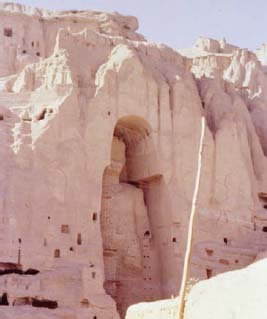The Medieval World, C. 400–1300India and Southeast Asia |
What is the significance of the recumbent Buddha? |
The Buddha is occasionally depicted reclining on his side with an arm tucked under his ear, while the other arm stretches the length of his body. This body positions indicates the Paranirvana, or death of the Buddha, in the Southeast Asian tradition (also popular in China and Japan). In Sri Lanka, a forty-six-foot-long sculpture of the recumbent Buddha was carved from a single, massive rock at a temple site known as Gal Vihara. Made sometime between the eleventh and twelfth centuries, this monumental representation of the Buddha’s Parinirvana shows the holy man surrounded by a smaller-scale mourner, likely his cousin, Ananda. A small pillow, carved from stone, supports the Buddha’s head; his face is round, and his thin robes appear to cling to his body in the traditional iconographic manner.

The enormous sixth-century Buddha at Bamiyan (in present-day Afghanistan) was destroyed by the Taliban in 2001.
